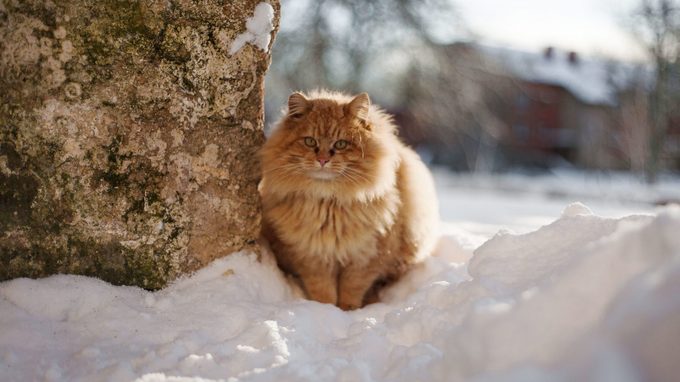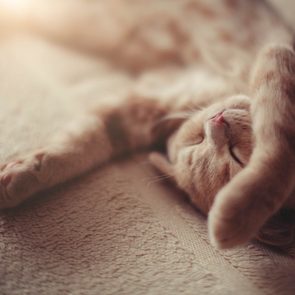If you have an outdoor cat, you need to know how cold is too cold for them to go outside during the winter months

How Cold Is Too Cold for Cats to Go Outside? A Vet Explains

Cats might have thick, fluffy coats, but that won’t fully protect them when temps start to drop. Sure, you can set your thermostat to a comfortable level, but if you let your cat outside to explore, you’ll need to keep an eye on the temperature to make sure it’s safe for them to be outdoors. Just how cold is too cold for cats to go outside in the winter?
To find out, we turned to Rover veterinarian Gary Richter, DVM, the medical director of Montclair Veterinary Hospital and the founder of Holistic Veterinary Care. He explained how cold is too cold for cats outside and what can happen if your pet goes out in frigid weather. Ahead, you’ll learn what temperature means it’s time to bring your cats indoors and if there are any precautions you need to take while keeping your feline friend safe and healthy.
Get Reader’s Digest’s Read Up newsletter for more pets, humor, cleaning, travel and fun facts all week long.
How cold is too cold for cats to go outside?
The moment you see the mercury dropping toward freezing, it’s time to question whether you should be letting your cat outside. “As a general rule, I would recommend bringing your cat inside the house if they don’t have a warm place to retreat to when the average daily temperature is lower than 45 degrees Fahrenheit—they shouldn’t be outside for any length of time at that temperature,” says Dr. Richter.
Having said that, 45 degrees is not a universal benchmark. Each cat has its own set of unique traits and characteristics. “Similar to dogs, it depends on a number of factors, such as age and coat thickness as well as if they are usually an outdoor cat or indoor cat,” he says. If your cat is accustomed to living outdoors, they’re smart and know the best places to find shelter and stay warm. If your indoor cat happens to get out when it’s cold, though, they’ll most likely be in more danger.
What can happen to your cat if it’s too cold outside?
If a cat’s body temperature falls below average, they can suffer from hypothermia, and if winds are high, they can get frostbite. Cold temperatures (even if they’re not yet below freezing), high winds and snow or rain (which can wet your cat’s coat) can bring these conditions on more quickly. “If the weather dips below freezing (32 degrees Fahrenheit), all cats are susceptible to hypothermia or frostbite,” says Dr. Richter.
So when you’re determining how cold is too cold for your cat to be outside, think about it from a practical perspective. Making your pet stay outdoors for too long is a serious cat-ownership mistake.
What can you do to keep your cat safe in the winter?
Keeping your cat safe goes beyond banning outdoor time when the temperature plummets—you’ll need to make sure your cat is comfortable indoors too. “Cats need more calories in colder weather, even if they stay indoors, so make sure your feline friend is always well-fed,” says Dr. Richter. He also recommends keeping your blinds open during the day so your indoor cat can get lots of sunshine.
If you have an outdoor cat, it can be difficult to get them to want to stay inside during the cold. If you absolutely must let your cat outdoors, make sure they have access to a warm shelter or permanent heated structure. If it becomes too cold for cats to be outside, they can keep themselves warm in the shelter. Consider adding a cat door to your home so they can easily come back inside.
Creating an outdoor shelter doesn’t have to be an elaborate process. Dr. Richter recommends taking an old storage container and creating insulation using straw (not blankets) to keep your pet—or stray cats that frequent your neighborhood—warm. You want to make sure they have enough space to move around but not so much space that it makes it difficult to keep it warm.
About the expert
|
Why trust us
At Reader’s Digest, we’re committed to producing high-quality content by writers with expertise and experience in their field in consultation with relevant, qualified experts. We rely on reputable primary sources, including government and professional organizations and academic institutions as well as our writers’ personal experiences where appropriate. We verify all facts and data, back them with credible sourcing and revisit them over time to ensure they remain accurate and up to date. Read more about our team, our contributors and our editorial policies.
Source:
- Gary Richter, DVM, veterinary health expert with Rover, medical director of Montclair Veterinary Hospital and founder of Holistic Veterinary Care























